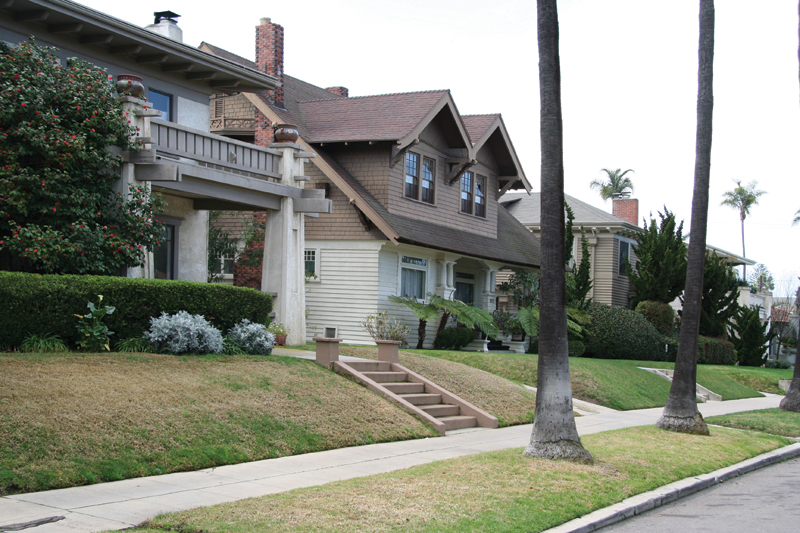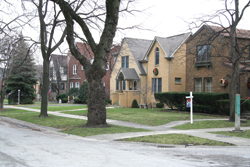|
Every Bungalow Represents our History
By Allen Hazard
Like a lot of Baby Boomers, I guess the first time I heard the word bungalow was when Jim Morrison sang about “a little girl in a Hollywood bungalow.” Funny, since at the time I was actually living in a bungalow. Maybe National City Bungalow just didn't have the same ring.
Fast forward to marrying a certain woman from Chicago, with whom I now live in our own Mission Hills bungalow. I'll never forget my first visit to Chicago in 1997. I felt like Ferris Bueller as I experienced my very own personal day off in Chicago - we went to a White Sox game, visited the Art Institute, checked out the modern public art downtown and capped off a memorable day by going to Buddy Guy's Southside blues club. The rich and abundant architectural resources, Louis Sullivan and Frank Lloyd Wright buildings, as well as the Chicago Bungalows, amazed me
 |
 |
(left) Bungalows along palm tree lined Sunset Boulevard in Mission Hills; (right) A similar streetscape in Chicago with that city's style of bungalows and regional street trees.
Now we travel to Chicago a couple of times a year, we stay with Janet's sister and family at their 1920s Bungalow and we always visit heritage landmarks. This past holiday season, we took a three hour bus tour to Hyde Park, the Gold Coast, Mies van der Rohe's IIT campus and many historic districts. We later took a self-guided walking tour to visit the Old Edgebrook Historic District. Chicago has done a great job at preserving their historic buildings.
My wife and I joined SOHO in 1999 after attending the Arts & Crafts Weekend in North Park and we fell in love with bungalows, so much so that we eventually bought our 1920 Craftsman bungalow. I have often wondered why Chicago has so many more bungalows than we do. There are 80,000 to 100,000 bungalows in Chicago or about one-third of their housing stock in the city. Contrast this with less than five percent of our housing stock; bungalows represent only a small fraction of this number. While, we are an older city (1769 to 1837), we have always been a smaller city, which might explain the difference in sheer numbers. But what explains the loss of so many of our bungalows? Was Chicago that much more hip to preservation than we were?
Than, a few years ago I picked up a wonderful book titled They All Fall Down, Richard Nickel's Struggle to Save America's Architecture. Nickel was a photographer and preservationist who, in the 1950's and 1960's, tried to save Louis Sullivan buildings as Mayor Richard J. Daley was tearing them down in the name of urban renewal. Chicago lost a lot of great architectural treasures, from modest bungalows to important Sullivan and Wright buildings. The book is a fascinating account of Nickel's work to document Sullivan buildings and save important artifacts. Tragically, Nickel died while salvaging Sullivan's Stock Exchange Building in 1972.
So, maybe Chicago was no different from us or most cities across the country, Chicago like San Diego has lost its share of historic buildings because of the failure of their city planners, developers, real estate agents, politicians and homeowners who didn't want to save their buildings and whose vision didn't include the soul of a city or the history of neighborhoods. There are more bungalows in Chicago because they started with more. It also makes me wonder what happened to our Victorians? Were they razed to make room for bungalows? Then bungalows were razed after WWII for ranch homes? The domino theory of homes?
Incredibly, San Diego continues to struggle and debate such issues as “Should every bungalow be saved?” Some at city hall believing that we have “too many bungalows” and that they can easily afford to destroy what little existing stock we have left to make way for greater density and McMansions. This is crazy! We don't have enough bungalows! I personally witness the loss of 4 or 5 every year in Mission Hills. Every bungalow is representative of our history and every bungalow is made up of irreplaceable natural resources like 200-year-old wood as well as the craftsmanship of a bygone era. My step dad and mom's humble bungalow in National City is just as important as my Mission Hills bungalow, for it too tells an important story.
We must all accept the responsibility of preservation in San Diego. Every modest bungalow lost strikes our soul, it slowly chips away at our past, our history and our legacy. Someday people will have to travel to historic districts just to view a bungalow. Historic districts will become defacto house museums. Unless we as a society learn that every bungalow is special we will end up with nothing but generic cookie cutter mass-produced houses.
For your next home, consider buying a bungalow, research it, have it historically designated, mobilize your community by forming a historic district, educate your real estate agent about the value of older homes, support political candidates who understand preservation. Recently, Chicago Mayor Richard M. Daley started the Chicago Bungalow Initiative, www.chicagobungalow.org, to save ALL bungalows, we must demand that our city do the same. Otherwise, we might as well be singing different Doors' lyrics, “When the music's over, turn out the lights,” or “This is the end, beautiful friend, the end of our elaborate plans, the end of everything that stands, the end.”
Allen Hazard is a frequent contributor to SOHO's publication. He and his wife, Janet are founding members of Mission Hills Heritage, www.missionhillsheritage.org. They have just started a new business devoted to early 20th century decorative arts at HazArts.com. Photos by Allen Hazard. |
MORE FROM THIS ISSUE
From the Editor
Most Endangered
A Brief History of Rancho Guejito
Another Part of the Story
The Threat
The Beauty of our State Parks in Peril
The Cultural Landscape Connection to Historic Preservation
What is a Cultural Landscape?
The Historic Home Landscape and Gardens
A Short Landscape Glossary
Importance of the Garden in Home Planning
When was Modern New?
Every Bungalow Represents our History
History Repeating
The Sherman-Glbert House
150th Anniversary of the Jackass Mail
Donations
Strength in Numbers
Lost San Diego
DOWNLOAD full magazine as pdf (15.4mb)
|





